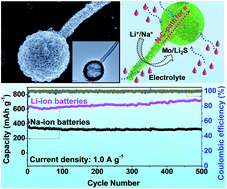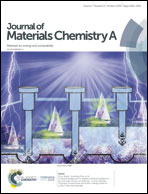Bio-inspired self-breathable structure driven by the volumetric effect: an unusual driving force of metal sulfide for high alkaline ion storage capability†
Abstract
Pursuing higher energy density and longer lifespan of alkaline ion batteries (i.e., Li+ and Na+) to satisfy the growing demand in the energy market remains challenging. One of the limitations is the graphite anode, which has limited lithium storage capability and is incapable of storing sodium. Herein, a unique metal sulfide-based anode with high capacity and extremely long cycle life was presented; a new concept of a self-breathable structure and hetero-atom doping features was introduced. In detail, a new aurilave-like structure composed of a metal sulfide shell and a nitrogen-doped carbon framework (e.g., N–C@MoS2) was constructed using natural spores as the template. Benefiting from the uniqueness of the bio-inspired structure and components, N–C@MoS2 exhibited extraordinary alkaline-ion storage performance with respect to rate capability, initial coulombic efficiency and cycle life, which were superior to those of most MoS2-based anodes reported before. We found that the inside of the aurilave structure served as a dynamic “electrolyte reservoir”, while the N–C skeleton acted as a “highway” for ion/electron transport, thereby leading to a deeper and faster conversion reaction rate. We hope that the bio-inspired architectures and components can be widely applied to design materials for other applications.



 Please wait while we load your content...
Please wait while we load your content...